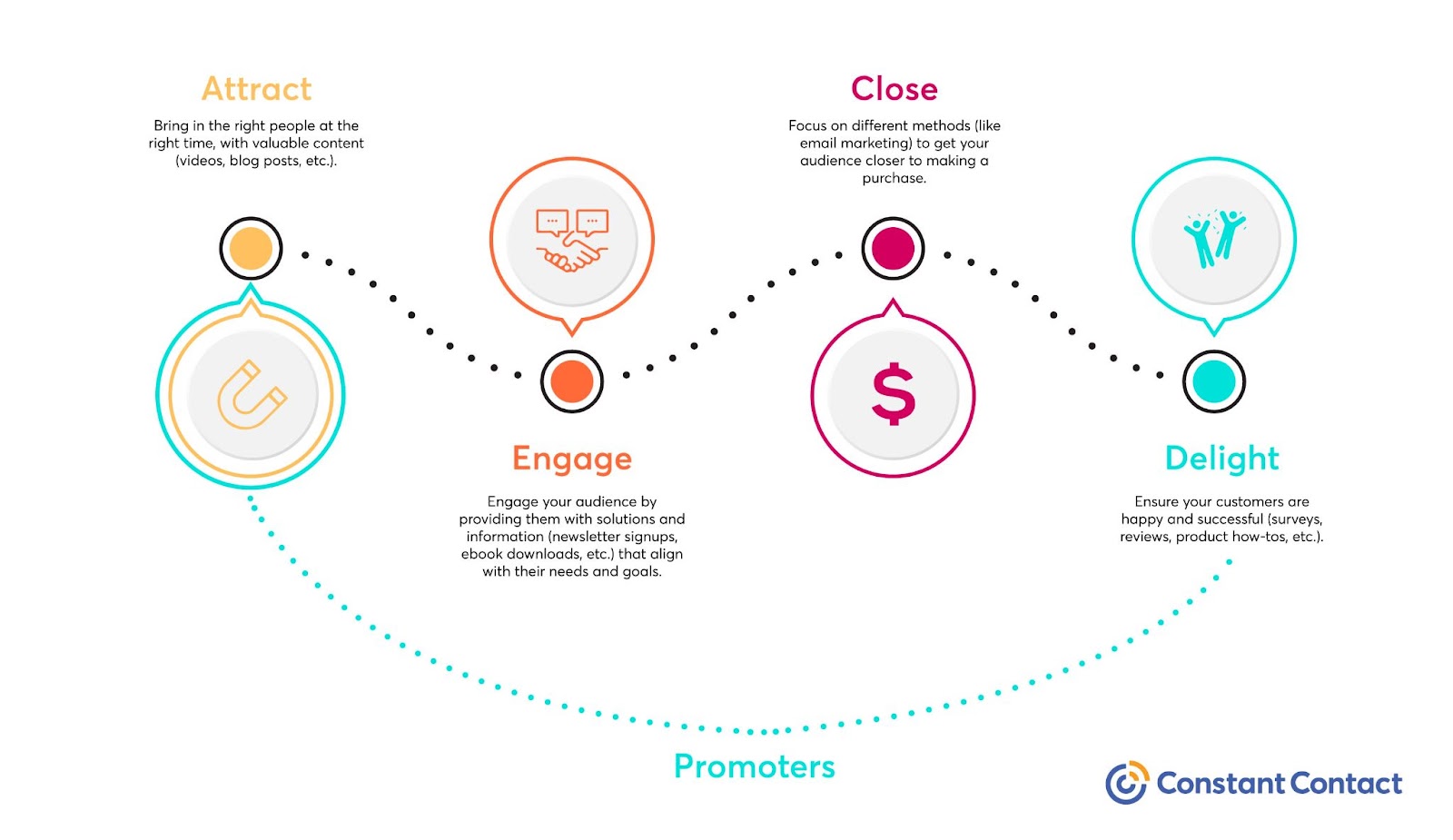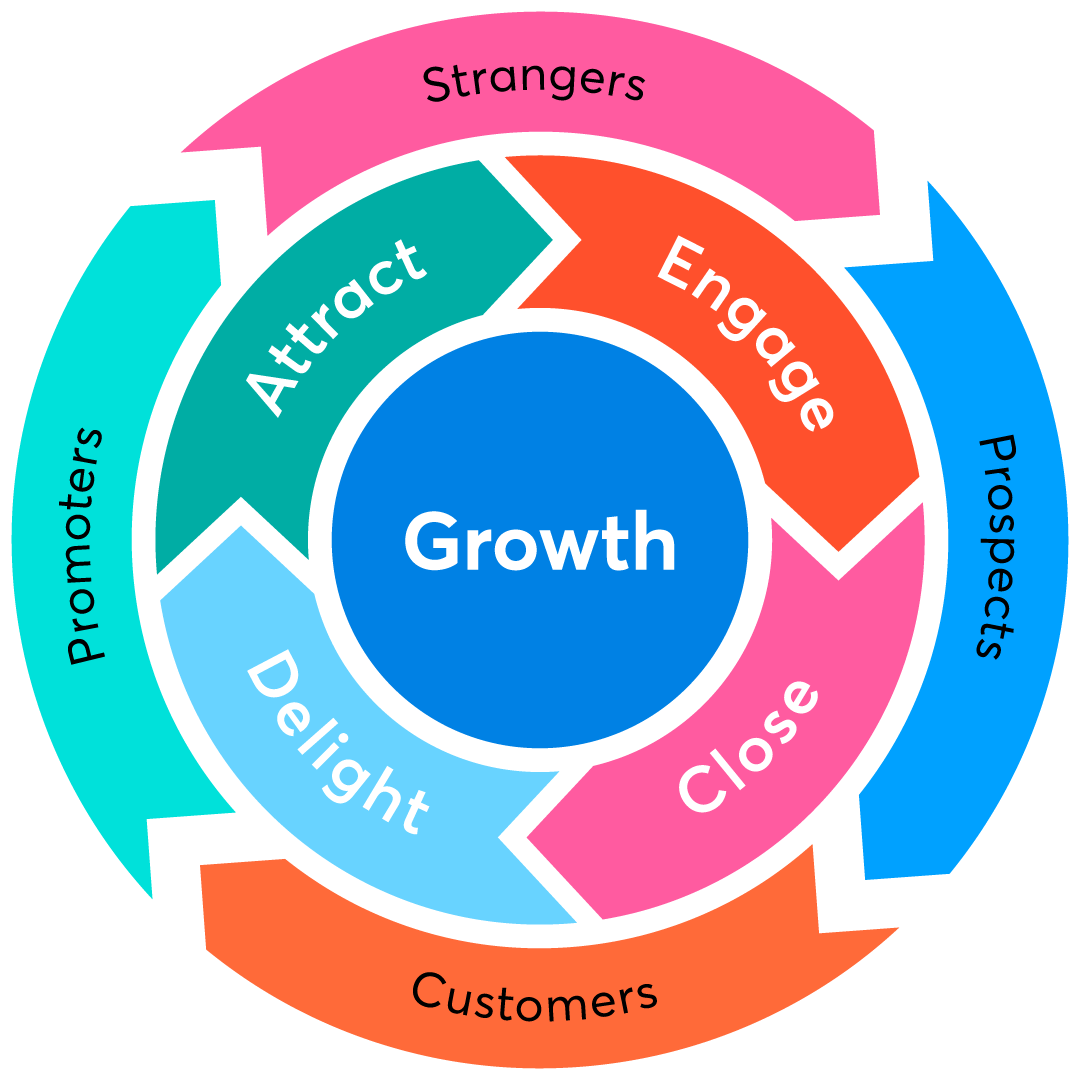
If you haven’t given much thought to inbound marketing, you might consider adding it to your radar. While it may be one of those digital marketing terms, you have kept in the back of your mind for a rainy day, focusing on inbound marketing now can be just what you need to elevate your marketing strategy.
Imagine, for example, you’re at a party. One partygoer awkwardly interjects into conversations, disrupting the light-hearted atmosphere, while another partygoer gracefully joins in with an easygoing nature, serving refreshments, and slowly works to build trust with everyone present before engaging in conversation.
The first partygoer is similar to outbound marketing, while the second partygoer is similar to inbound marketing. If you had to choose, you’re probably more likely to continue to engage with the second partygoer. This is because the second partygoer is allowing you to make the choice of when to engage based on your wants and comfort level.
This makes inbound marketing so powerful, it allows you to be in front of your audience when they are ready to hear your messages. In fact, businesses that apply inbound marketing tactics can generate as high as 126% more leads than those that don’t.
What is inbound marketing?
Inbound marketing aims to attract customers by providing valuable and relevant content or experiences. It’s a form of demand generation designed to draw prospects in, unlike traditional (or outbound marketing), which outwardly pushes a brand, product, or service.
It’s similar to turning on the bright lights and music of a carnival or fair; as you walk by, the lights and sounds draw you in with fun and excitement, so you willingly make your way toward it. Whereas outbound marketing is similar to someone shouting at you through a megaphone telling you there is a carnival down the street.
Examples of inbound marketing include both ‘earned’ and ‘owned’ media, such as:
- Blogs
- Ebooks
- Webinars
- Social media posts
- Videos
- Infographics
- Whitepapers
- News articles
- Research papers
- Landing pages
- Case studies
- User-generated content
While we all aspire to do it all, graphic design, website development, content creation, and social media management are all ideal marketing tasks to outsource or you can incorporate marketing automation to make the most out of your time and still maximize your inbound marketing efforts.
Why inbound marketing is important
Inbound marketing helps businesses attract and engage customers in a non-invasive way.
Instead of using traditional advertising messages to push your message out into the world, inbound marketing focuses on creating valuable and educational content that draws people to your brand.
By providing people with what they are looking for, you naturally build trust and credibility, making them more likely to choose your business when it comes time for them to make a purchase. Not to mention, inbound marketing is more cost-effective and produces better results than traditional advertising. In fact, inbound marketing costs $14 less than traditional marketing for each newly acquired customer.
Inbound marketing benefits
Inbound marketing can help businesses grow and thrive by naturally drawing potential customers in rather than interrupting them with intrusive ads. While there are many benefits to inbound marketing, here are a few of the most notable ones:
- Everything is in context
- Cost-effective
- Better qualified leads and conversion rates
- Increases brand awareness and trust
- Encourages the use of more than one marketing channel
Everything is in context
Instead of blasting generic marketing messages to a wide audience, inbound marketing focuses on bringing customers to you through targeted content relevant to their needs and interests.
Cost-effective
By focusing on creating valuable content that attracts customers to your business, inbound marketing can be a more affordable way to generate leads. In fact, leads acquired after five months of consistent inbound marketing are 80% less expensive than outbound leads. In addition, the cost per lead generated by inbound marketing is 60% less than outbound generated leads.
Better qualified leads and conversion rates
As your audience searches for solutions to their needs, inbound marketing puts your content (and brand) in front of them. Because you’re attracting customers who are actively seeking out information and solutions related to your offerings, they are more likely to be genuinely interested in what you have to offer. This puts you in front of the right audience at the right time, providing you with quality traffic, leads, and better conversion rates.
Increases brand awareness and trust
By consistently delivering high-quality content that speaks to your audience’s needs and interests, you can build a strong and positive reputation within your industry. This can help to boost your credibility and encourage customers to choose your brand over competitors.
Encourages the use of more than one marketing channel
Creating various content types and formats, such as blog posts, videos, social media posts, infographics, etc., allows you to reach customers across various platforms and touchpoints. This can help build a more diverse and engaged audience while increasing the chances your message will be seen and heard.
Inbound marketing vs. outbound marketing
While inbound marketing and outbound marketing have the same goals — increasing conversions and sales — they are different in how they approach potential customers.
Outbound marketing (interruption-based): Similar to the megaphone from our earlier analogy, outbound marketing actively reaches out to your audience to gauge their interest in your brand or product. Examples of outbound marketing include TV advertisements, radio ads, direct mail, social media campaigns, Google ads, billboards, cold calling, etc.
Inbound marketing (permission-based): Remember the lights and sounds from the carnival, drawing prospective customers in? That is inbound marketing. Unlike outbound marketing, inbound marketing brings your audience to you by creating content (blogs and ebooks) or taking advantage of earned media (social media shares and customer reviews). This helps develop a relationship and trust between you and your audience — making them more likely to purchase from you later.
Combining the use of both inbound and outbound marketing will allow you to create a comprehensive and impactful marketing strategy to maximize your return on investment (ROI). Inbound marketing attracts potential customers, while outbound marketing directly reaches out to them. Taking advantage of both methods will increase brand awareness and leads, as well as convert those leads into paying customers.
How inbound marketing works
Inbound marketers understand that the key to success is not only about getting their audience’s attention but also about building a long-term relationship with them. To achieve this, successful businesses employ the following:
Inbound marketing strategy
The inbound marketing approach is divided into four stages: attract, engage, close, and delight. These four stages make up the inbound marketing funnel.

Attract
The attract stage of the journey is all about bringing in the right people at the right time, with valuable content (videos, blog posts, SEO) that establishes you as a thought leader who can help them.
Strategies:
- Create and publish content that provides value (videos, blogs, etc.)
- Establish an SEO strategy targeting keywords and phrases that relate to your brand or product, problems you solve, and topics that interest your target audience.
- Post content consistently to social media to increase your audience reach and engagement.
Engage
Engagement does exactly that — it engages your audience by providing them with solutions and information (newsletter signups, ebook downloads, etc.) that align with their needs and goals, making them more likely to purchase from your company.
Strategies:
- Encourage your audience to sign up for your newsletter
- Establish a gated content strategy for longer-form content (like ebooks and whitepapers)
Close
Once you have engaged your audience and caught their attention, the close stage begins to focus on different methods (like email marketing) to move them closer to making a purchase.
Strategies:
- Establish email marketing automations to guide your audience to a purchase
Delight
Now that your audience has made a purchase, the delight phase focuses on ensuring your customers are happy and successful (surveys, reviews, product how-tos, etc.), turning them into advocates for your brand or company.
Strategies:
- Utilize surveys to request customer feedback, so they know their opinion matters
- Use analytics and social listening tools to measure the success of your strategy and make adjustments as needed.
Creating an effective inbound marketing funnel requires an understanding of your audience’s needs and wants. Buyer personas, also known as customer avatars (fictional representations of your ideal customers based on market research and data), can give you a deeper understanding of your target audience.
This information is important when creating content and experiences that will resonate with them and drive conversions.
It’s the difference between an outfit you bought off the rack or one you had custom-made — sure, the one off the rack might fit, but since it’s designed for everyone, it will not fit your body perfectly — the way a custom outfit would. Not to mention, when you have a clear image of who you are speaking to, it makes it easier to create a consistent, targeted, and effective inbound marketing strategy that will seamlessly guide your audience through each stage.
The flywheel strategy

The flywheel strategy takes these four stages a step further. It emphasizes the importance of taking the stages and using them to create a positive feedback loop between your business, customers, and marketing efforts.
The main idea of the flywheel strategy is that satisfied customers are more likely to become advocates for a business, thus creating a self-sustaining cycle of the stages listed above, which can attract new customers and lead to increased sales. It’s different from traditional marketing approaches in that it focuses on building customer relationships by creating an exceptional customer experience through personalized interactions, useful content, and targeted marketing campaigns over acquiring new customers. By building strong customer relationships, you can create momentum that drives growth and success over time, similar to how a flywheel gains momentum as it spins.
You start by attracting your audience to your site through various marketing techniques. Then you engage with them with valuable content, turn them into customers by closing the sale, and finally, delight them with exceptional customer service. As you build these relationships, they become your brand advocates and help attract even more visitors to your site.
The flywheel strategy helps keep your marketing efforts focused on your ideal customer, resulting in a more personalized and fulfilling experience for them.
Inbound marketing trends
Inbound marketing is a constantly evolving field, with new strategies emerging all the time. Here are some inbound marketing trends currently making waves in the industry.
- Micro-influencers
- Interactivity
- AI
- Location-based marketing
- Personalization
- Video marketing
- Marketing automation
Micro-influencers
Businesses are increasingly joining the micro-influencer trend, especially as consumers become wary of celebrity endorsements. Micro-influencers are known for their authenticity and relatability, and their followers trust them—allowing them to easily sway audience behavior. This allows small businesses to build brand trust, connect with their target audience on a more personal level, and promote their offerings. Not to mention, micro-influencers have a lower cost and a higher ROI than celebrity endorsements.
Interactivity
Interactive content such as quizzes, polls, and surveys is also rising. With information excess and dwindling attention spans, interactive content is a great way to engage your audience and encourage them to take action as it goes beyond what traditional content can do (inform and entertain) and invites them to participate and engage. By providing interactive content, you can gather valuable data about your audience’s preferences and behaviors, allowing you to create more targeted and effective marketing campaigns.
AI
The use of AI is increasing as technology is becoming more advanced. AI-powered chatbots, for example, can interact with customers in real-time, providing personalized responses and support. They can also be used to gather valuable customer data and insights, allowing you to fine-tune your marketing strategies.
Location-based marketing
Location-based marketing is another trend gaining popularity thanks to the growing use of mobile devices. By using data on a customer’s location, you can send them personalized messages and promotions based on their proximity to your business or their location. This can be particularly effective for driving foot traffic to physical stores or events.
Personalization
Personalized marketing based on the individual needs and preferences of customers is going to continue to increase and gain popularity, especially as customers expect a more custom experience. Businesses that can provide this type of experience by gathering the data, insights, and information on customer behavior that we have access to are more likely to build loyalty and drive sales.
Video marketing
With platforms like YouTube, Instagram, and Tiktok, videos continue to be a powerful way for businesses to connect with customers and build brand awareness as they are more engaging and easy to consume. Whether through product demos, tutorials, or behind-the-scenes content, creating videos that are easy to digest and useful will result in increased conversion rates and ROI.
Marketing automation
As marketing automation technology continues to advance, more businesses are adopting this tool to free up time and resources, reduce errors, streamline internal processes, and manage multi-touch campaigns, allowing them to focus on more strategic initiatives. From email campaigns to social media scheduling, automation allows businesses to streamline their marketing efforts and deliver more targeted and personalized messages to their audiences.
How to get started implementing inbound marketing
With the right tools and strategy, inbound marketing can be a cost-effective and efficient way to reach and engage your target audience.
Ensure you have the right toolset
Inbound marketing often involves managing multi-channel campaigns. Managing these campaigns can be simplified with the right tools, such as a marketing automation platform. This can help you keep up with demands and provide valuable data insights so you can easily adapt your marketing strategy as needed.
Strengthen your website and social media presence
Ensure you have a strong social and website presence; incorporate relevant keywords, test CTAS, create engaging content, and leverage social media to drive traffic to your site.
Optimize your content for SEO
Be sure your content is SEO optimized. By optimizing your content, you can be sure your audience will find it when searching for specific keywords.
Combine your inbound and outbound strategies
Incorporating your inbound marketing into your outbound marketing strategy where it makes sense will allow you to reach your audience through multiple marketing channels, elevate your overall marketing strategy, and allow you to segment your audience so they receive relevant and timely messages.
By taking these action items, you can build a robust, inbound marketing strategy that drives traffic, leads, and sales for your business.
Begin with Content
Inbound marketing is an effective approach to attracting and engaging your target audience, building long-term relationships, and driving business growth.
But before you get started, it’s important to understand the audience you are trying to reach and what they are searching for (solutions and information). Once you’re clear on your audience’s needs and wants, create content relevant to them.
TIP: Utilize social media platforms to share and promote content. This will help increase your reach and engagement with potential customers.
By creating valuable content that resonates with your audience and distributing it through the right channels, you can position yourself as a trusted authority in your industry and win the hearts and minds of your audience.




